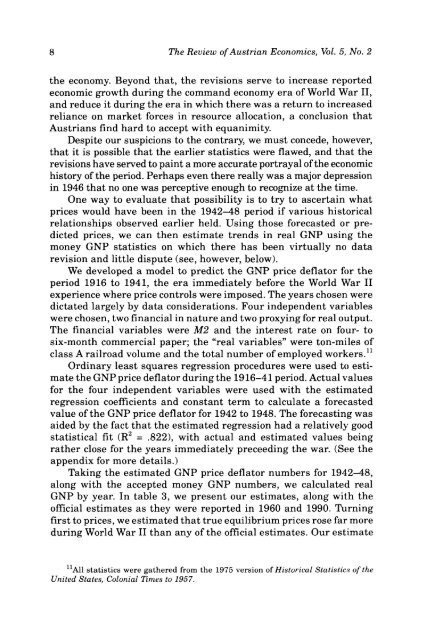Review of Austrian Economics - The Ludwig von Mises Institute
Review of Austrian Economics - The Ludwig von Mises Institute
Review of Austrian Economics - The Ludwig von Mises Institute
Create successful ePaper yourself
Turn your PDF publications into a flip-book with our unique Google optimized e-Paper software.
8 <strong>The</strong> <strong>Review</strong> <strong>of</strong> <strong>Austrian</strong> <strong>Economics</strong>, Vol. 5, No. 2<br />
the economy. Beyond that, the revisions serve to increase reported<br />
economic growth during the command economy era <strong>of</strong> World War II,<br />
and reduce it during the era in which there was a return to increased<br />
reliance on market forces in resource allocation, a conclusion that<br />
<strong>Austrian</strong>s find hard to accept with equanimity<br />
Despite our suspicions to the contrary, we must concede, however,<br />
that it is possible that the earlier statistics were flawed, and that the<br />
revisions have served to paint a more accurate portrayal <strong>of</strong> the economic<br />
history <strong>of</strong> the period. Perhaps even there really was a major depression<br />
in 1946 that no one was perceptive enough to recognize at the time.<br />
One way to evaluate that possibility is to try to ascertain what<br />
prices would have been in the 1942-48 period if various historical<br />
relationships observed earlier held. Using those forecasted or predicted<br />
prices, we can then estimate trends in real GNP using the<br />
money GNP statistics on which there has been virtually no data<br />
revision and little dispute (see, however, below).<br />
We developed a model to predict the GNP price deflator for the<br />
period 1916 to 1941, the era immediately before the World War II<br />
experience where price controls were imposed. <strong>The</strong> years chosen were<br />
dictated largely by data considerations. Four independent variables<br />
were chosen, two financial in nature and two proxying for real output.<br />
<strong>The</strong> financial variables were M2 and the interest rate on four- to<br />
six-month commercial paper; the "real variables" were ton-miles <strong>of</strong><br />
class A railroad volume and the total number <strong>of</strong> employed workers. 11<br />
Ordinary least squares regression procedures were used to estimate<br />
the GNP price deflator during the 1916-41 period. Actual values<br />
for the four independent variables were used with the estimated<br />
regression coefficients and constant term to calculate a forecasted<br />
value <strong>of</strong> the GNP price deflator for 1942 to 1948. <strong>The</strong> forecasting was<br />
aided by the fact that the estimated regression had a relatively good<br />
statistical fit (R 2 = .822), with actual and estimated values being<br />
rather close for the years immediately preceeding the war. (See the<br />
appendix for more details.)<br />
Taking the estimated GNP price deflator numbers for 1942-48,<br />
along with the accepted money GNP numbers, we calculated real<br />
GNP by year. In table 3, we present our estimates, along with the<br />
<strong>of</strong>ficial estimates as they were reported in 1960 and 1990. Turning<br />
first to prices, we estimated that true equilibrium prices rose far more<br />
during World War II than any <strong>of</strong> the <strong>of</strong>ficial estimates. Our estimate<br />
All statistics were gathered from the 1975 version <strong>of</strong> Historical Statistics <strong>of</strong> the<br />
United States, Colonial Times to 1957.

















